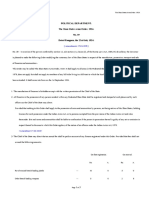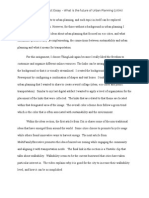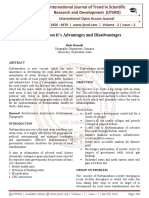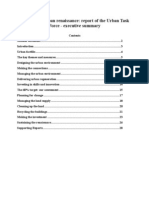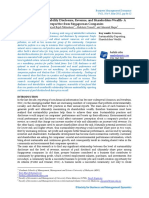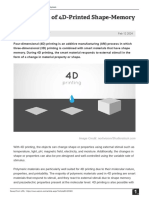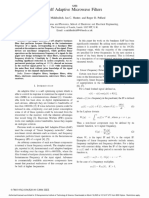Conceptualizing Rurality
Uploaded by
Juan Ruiz-UrquijoConceptualizing Rurality
Uploaded by
Juan Ruiz-UrquijoThe Handbook of Rural Studies
Conceptualizing Rurality
Contributors: Paul Cloke & Terry Marsden & Patrick Mooney
Print Pub. Date: 2006
Online Pub. Date: June 22, 2009
Print ISBN: 9780761973324
Online ISBN: 9781848608016
DOI: 10.4135/9781848608016
Print pages: 18-29
This PDF has been generated from SAGE Knowledge. Please note that the pagination
of the online version will vary from the pagination of the print book.
SAGE KNOWLEDGE - FACULTY
Copyright 2012
SAGE Publications, Inc.
10.4135/9781848608016
[p. 18 ]
Chapter 2: Conceptualizing Rurality
Paul Cloke
Introduction: Changing Ruralities
The idea of rurality seems to be firmly entrenched in popular discourses about space,
place and society in the Western world. Although the precise nomenclature devoted
to the idea is often context-specific witness the sometimes subtle but always
important differences in terms such as rural, countryside, country, wilderness, outback,
agricultural and so on the concept of rurality lives on in the popular imagination and
everyday practices of the contemporary world. The rural stands both as a significant
imaginative space, connected with all kinds of cultural meanings ranging from the idyllic
to the oppressive, and as a material object of lifestyle desire for some people a
place to move to, farm in, visit for a vacation, encounter different forms of nature, and
generally practise alternatives to the city. Given the significance of its imaginative and
material status, it is surprising how often we seem to lack an adequate understanding
of how the concepts that underpin the idea of rurality should be defined and made
relevant. It is almost as if the strength of the idea of rurality is in its overarching ability
to engage very different situations under a single conceptual banner. Yet as soon as
attempts are made to deconstruct the rural metanarrative, much of that conceptual
strength dissipates into the nooks and crevices of particular locations, economic
processes and social identities. Part of the issue here is that the distinction of rurality is
significantly vested in its oppositional positioning to the urban. While cities are usually
understood in their own terms, and certainly without any detectable nervousness
about defining or justifying that understanding, rural areas represent more of a site of
conceptual struggle, where the other-than-urban meets the multifarious conditions of
vastly differing scales and styles of living.
Page 2 of 19
The Handbook of Rural Studies: Conceptualizing
Rurality
SAGE knowledge
SAGE KNOWLEDGE - FACULTY
Copyright 2012
SAGE Publications, Inc.
In this chapter I want to survey some of the different ways in which rurality has been
framed conceptually, signposting along the way some potentially fruitful and imaginative
ways of exploring further the mysterious cartographies of the rural. To begin with,
however, it is important to emphasize that understandings of rurality are influenced by
twin tracks of changing perspectives not only do we need to survey how different
theoretical frames illuminate very different pictures of rurality (and indeed steer rural
research down very different pathways) but we also need to be fully aware of the
(sometimes rapidly) changing conditions of rural life, rural place and rural political
economy which together constitute important shifts in the material manifestation
of rurality. The changes occurring in rural areas themselves are such that even a
consistent theoretical frame will need to cope with considerable dynamism within its
rural subject.
Many of these rural changes are discussed and problematized in the individual chapters
of this Handbook, but it warrants emphasis at this point not only that rural change
has constituted a blurring of conventional boundaries between country and city, but
also that such blurring works in both directions, indicating an urbanization of the rural
and (albeit to a lesser extent) a ruralization of the urban. Urbanizing the rural has
occurred via an interwoven tapestry of cultural, social and economic trends. The
urbanization and indeed globalization of cultural dissemination through broadcast and
print media and especially the [p. 19 ] Internet, means that most seemingly rural
places in the Western world are effectively culturally urbanized. Although distinctive
cultural traits are formed in particular globalizations of the local and localization
of the global in rural areas, the all-pervading messages of Hollywood, MTV and
Google mean that the idea of rurality as an isolated island of cultural specificity and
traditionalism has become anachronistic. At the same time, over the past 30 years
there has been a hugely significant influx of urban populations into rural locations. Inmigrants have been attracted to rural locations because of the perceived advantages of
rural lifestyles, yet at the same time they bring with them key attributes of urban living
and levels of expectation which often serve to transform the very communities they
had been attracted to. Demographic change has both shaped and been shaped by
economic change. As the scale of agricultural workforces has diminished, the traditional
dominance of the agricultural economy in rural areas has gradually shifted in emphasis
from landscapes of production to landscapes of consumption. Economic diversity has
Page 3 of 19
The Handbook of Rural Studies: Conceptualizing
Rurality
SAGE knowledge
SAGE KNOWLEDGE - FACULTY
Copyright 2012
SAGE Publications, Inc.
been fuelled first by urban-to-rural shifts in manufacturing, and then by new forms of
service sector activity, prompted in part by the ability of telecommunications, information
technology and increases in personal mobility to shrink the geographic distances
between city and country.
These generalizations, of course, mask very considerable variations in and between
nations, where different scales and cultures of urban-rural differentiation exert
different pressures on these broader processes of blurring. However, such variations
notwithstanding, it is easy to agree with Mormont (1990) that the changing relationship
between space and society has rendered traditional divisions between rural and urban
increasingly indistinct. Rural society and rural space can no longer be seen as welded
together. Rather, rurality is characterized by a multiplicity of social spaces overlapping
the same geographical area, so while the geographic spaces of the city and the
countryside have become blurred it is in the social distinction of rurality that significant
differences between the rural and urban remain.
Accounts of the ruralization of the urban have received less emphasis in explaining how
town and country distinctions have become blurred. However, two illustrations suffice
here to support the argument that rural change does not simply imply a takeover of the
rural by urban values and forms. The first is drawn from Wilson's (1992) account of how
recent land development in North America has produced suburbs, shopping centres,
theme parks, executive estates, tourist development and the like which destabilize
ideas about city and country by producing city/country hybrids which owe as much to
a bringing-nature-into-the-city as to a spreading-the-city-into-the-country. He illustrates
this idea with an account of the West Edmonton Mall in Canada, a 45 hectare suburban
indoor shopping centre which includes a one-hectare lake replete with dolphins and
sharks, an 18-hole golf course, a water park with six-foot surfing waves and a zoological
collection of animals in cages and aquariums. Such developments cannot simply be
dismissed as a colonizing commodification of rural nature into urban forms, as the very
presence of pseudo-rural landscapes, creatures and practices opens out imaginative
spaces of the rural in these hybrid settings.
The second example can be found in the arguments deployed by Urbain (2002) about
the ruralizing of the metropolis. Despite the emphasis on how counter-urbanization has
urbanized the countryside, Urbain insists that the spread of the city out into the country
Page 4 of 19
The Handbook of Rural Studies: Conceptualizing
Rurality
SAGE knowledge
SAGE KNOWLEDGE - FACULTY
Copyright 2012
SAGE Publications, Inc.
has effectively ruralized a very significant part of the urban. Given that the nature of the
city has been radically changed, both by centralizing tendencies and by decentralizing
practices, it can be argued that an important slice of contemporary urbanity can now
be found in the village, and that the urban form thereby now encapsulates very strong
rural characteristics and influences. Equally, urban managers seem increasingly to be
striving for a set of virtues in the city which are more commonly associated with the
rural seemingly fundamental and permanent virtues such as protection, solidarity,
community spirit and identity. According to these arguments, then, the blurring of
rural-urban distinctions is bringing crucial changes to urbanity as well as to rurality.
Such changes present any conceptual framing of the rural with considerable dynamic
complexity as to the nature of the subject being framed.
Rurality: The Shifting Theoretical Lens
At least some of the changing narrative of rural studies has been framed around the
use of different theoretical perspectives to make sense of and to define the essential
characteristics of rurality. The ways in which such theoretical approaches make inroads
into rural literatures varies significantly between different social science disciplines. It
would not be unfair to suggest that some subject areas have witnessed a reluctance
in the main [p. 20 ] to depart from broadly positivistic approaches (agricultural
economists, with some notable exceptions, seem to illustrate this tendency), while
others (and here geographers are an obvious example) have tended very readily
to embrace alternative theoretical movements as they come along. For some rural
researchers, then, the progressive introduction of new theoretical takes on rurality is
nothing more than surrendering to the vagaries of conceptual fashion, while for others,
fresh theoretical inputs have opened out new channels of inquiry and understanding
about the complex nature of rurality.
In broad terms it is possible to recognize three significant theoretical frames which
have been influential in constructing conceptualizations of rurality. The first, in some
ways not explicitly theoretical at all but in other ways engendering implicitly theoretical
assumptions, can be thought of as functional concepts of rurality. Here, the search has
been to identify functional elements of rural place/landscape/society/ existence which
Page 5 of 19
The Handbook of Rural Studies: Conceptualizing
Rurality
SAGE knowledge
SAGE KNOWLEDGE - FACULTY
Copyright 2012
SAGE Publications, Inc.
together provide an approximation of the overarching concept of rurality. In this manner,
rurality can be defined in terms of areas which:
1. are dominated (either currently or recently) by extensive land uses, notably
agriculture and forestry;
2. contain small, lower order settlements which demonstrate a strong
relationship between buildings and extensive landscape, and which are
thought of as rural by most of their residents;
3. engender a way of life which is characterized by a cohesive identity based
on respect for the environmental and behavioural qualities of living as part of
an extensive landscape (see Cloke and Park, 1984).
Underpinning these functional ideas, however, are a series of assumptions about
the relationship between the rural and the urban. For example, some research
in rural studies persistently conflates the rural with the agricultural, as if each is
somehow interchangeable. There is a suspicion that such conflation merely brings
easy settlement to the difficult conceptual issues raised by the blurring of city and
countryside discussed above. At least an agricultural focus appears safe conceptually
as agricultural production and landscapes (although not markets nor consumption) can
confidently be confined to a rural domain. However, these and other devices which
assume a functional centrality for rurality often appear to reproduce implicit forms of
rural-urban dichotomy or continuum. Tonnies's (1957) theorization of Gemeinschaft
(community) and Gesellschaft (society), which has been taken to reflect the intimate
rural and impersonal metropolitan polarities of the dichotomous rural-urban relationship,
has generally been superseded by the adoption of continuum models (Pahl, 1965),
which suggest a sliding scale of differences between rural and urban poles. Despite
strong warnings to the contrary (see, for example, Carlson et al., 1981; Lee and Newby,
1983), these loose concepts continue to underpin aspects of rural studies which see
rural areas as functionally different to their urban counterparts. Sadly, empirical work
conducted on this basis is often flawed because of arbitrary spatial boundaries of
available data, or because of the arbitrary nature of supposed indicators of rurality (see,
for example, Cloke, 1977).
A second conceptual landmark is represented by the use of political-economic concepts
to clarify the nature and position of the rural in terms of the social production of
Page 6 of 19
The Handbook of Rural Studies: Conceptualizing
Rurality
SAGE knowledge
SAGE KNOWLEDGE - FACULTY
Copyright 2012
SAGE Publications, Inc.
existence (Cloke, 1989). Here, what had been previously recognized as functional rural
areas have been increasingly connected into the dynamics of national and international
political economy which have often been seen to operate on an aspatial basis. Through
this conceptual lens it became apparent that much of what happens within rural areas is
caused by factors operating outside the supposed boundaries of these areas. Rurality
as an analytical category was desensitized in many of these discussions, and rural
researchers were invited to do away with rural (Hoggart, 1990) as an intellectual
container and to seek out sectoral research that spanned across previous rural-urban
distinctions. This emphasis on the power fields and apparatus of social production
effectively sponsored a conceptual blurring of the rural and the urban, and reinforced
the concern of rural research with particular sectors, for example, the food sector,
which impacted on areas beyond the urban. During the 1980s, the localities debate in
Britain further destabilized the spatial basis for rural studies, confirming as it did that
although certain places achieve a kind of uniqueness associated with local society
within broader processes of political economic restructuring, nevertheless rural places
did not in general represent distinct localities:
various critical notions of different, overlapping spatial divisions of
labour, of all localities as sites for the reproduction of labour-power, of
variations in local social structures etc. -render problematic the notion
that there are distinct rural localities.
(Urry, 1984: p. 198)
[p. 21 ] The adoption of political economic perspectives did not entirely unplug the
research focus on rurality, however. The insistence (see, for example, Dunleavy, 1982)
that to study rural anything (and by implication urban anything) was to misrepresent
prevailing socio-economic structures was tested out by researchers such as Moseley,
who did indeed conclude that
the inner city and outer rural areas share certain problems relating to a
declining or static population and economy and to the selective loss of
certain kinds of people and jobs.
(1980: p. 26)
Page 7 of 19
The Handbook of Rural Studies: Conceptualizing
Rurality
SAGE knowledge
SAGE KNOWLEDGE - FACULTY
Copyright 2012
SAGE Publications, Inc.
However, he also suggested significantly that structural problems common to urban and
rural areas are often manifest differently in rural areas -that there is a rural dimension
co-constituted by three basic characteristics:
1. A pleasant environment which will attract the willing or unwilling
unemployed.
2. A spaced-out geographical structure which leads to accessibility problems
and costly public services.
3. A distinctive local political ideology which favours the market, the volunteer
and the self-helper rather than public sector intervention.
So while many rural researchers grasped the political-economy initiative in order to
focus on the changing nature of agricultural production, tracing the shift from Fordist
to post-Fordist sets of social relations (Kenney et al., 1989, 1991; Sauer, 1990),
others deployed regulationist ideas to investigate the idea of a rural dimension. For
example, Harvey's (1985) argument that the configuration of mode of regulation and
societalization occurs as an ensemble of multi-faceted relations and institutions which
produce structured coherences at particular places and at particular times was taken
up in the rural arena to investigate the idea of particular rural structured coherences
(Cloke and Goodwin, 1992, 1993). The rural dimension, then, may not be incompatible
with political economic approaches precisely because the particularities of time and
place cannot be disconnected from the social construction of certain time-places as
rural. While it is important to emphazise that the changing functions of rural areas are
certainly not uniform or predictable, and that it is crucial to avoid over-generalization,
there do seem to be grounds for proposing that the idea of a socially constructed rurality
need not be incompatible with concepts that locate specific places and people in wider
models of changing relations:
Indeed, it may be crucial that the contracts and strategies of capital
in altering institutional forms, networks and norms, the impact of
the contesting of change in sociopolitical spheres, and the role of
cultural factors as a glue in establishing locally coherent characteristics
are brought together in our analysis rather than being regarded as
belonging to separate philosophical domains.
Page 8 of 19
The Handbook of Rural Studies: Conceptualizing
Rurality
SAGE knowledge
SAGE KNOWLEDGE - FACULTY
Copyright 2012
SAGE Publications, Inc.
(Cloke and Goodwin, 1993: p. 174)
The third theoretical framing of rurality, therefore, involves social constructions of
rurality, and draws on more postmodern and post-structural ways of thinking, especially
about the role of culture in socio-spatial distinctiveness. Regarding rurality as socially
constructed suggests that the importance of the rural lies in the fascinating world of
social, cultural and moral values which have become associated with rurality, rural
spaces and rural life. Such an approach invites study of how practice, behaviour,
decision-making and performance are contextualized and influenced by the social
and cultural meanings attached to rural places. As a starting point, there has been
significant interest in how idyllized meanings of rurality are constructed, negotiated
and experienced (Bunce, 1994, 2003), and there is an emerging core of significance in
rural studies which focuses on the interconnections between socio-cultural constructs
of rurality and nature which appear to be so important in the reproduction of
geographical imaginations of rural space and the actual lived experiences and
practices of lives in these spaces. These practices and lives need to be examined
both from the outside looking in (accounting for structuring influences) and from the
inside looking out (accounting for difference, identity and embodiment). Researchers
have also become increasingly aware of the need to extend beyond the obvious
interconnections between social construction and rural practice. In his review of
neglected rural geographies in Britain, Philo (1992) contends that most accounts of
rural life have viewed the mainstream interconnections between culture and rurality from
the perspective of typically white, male, middle-class narratives. He points clearly to a
need to explore other windows onto the rural world.
The meanings associated with rurality are not simply derived from differences between
individuals and organizations. Other, vital, differences emerge from the divergences
of rural society and rural space noted by Mormont above. Drawing significantly on the
writings of Baudrillard, Halfacree (1993) identifies three levels of divergence which
underpin the multiple meanings of rural in contemporary society. He suggests that
[p. 22 ] the sign (rurality) is becoming increasingly detached from the signification
(meanings of rurality) due to the increasingly diverse social representations of rurality.
Moreover, sign and signification are becoming increasingly divorced from their referent
(rural geographical space). Thus symbolic notions of the rural have become detached
from their referential moorings, meaning that socially constructed rural space has
Page 9 of 19
The Handbook of Rural Studies: Conceptualizing
Rurality
SAGE knowledge
SAGE KNOWLEDGE - FACULTY
Copyright 2012
SAGE Publications, Inc.
become ever more detached from geographically functional rural space, so much
so that we might now regard rurality in terms of a post-rurality (Murdoch and Pratt,
1997), in which consumers of the rural realize that rurality represents an inau-thentic
pastiche of meanings and symbols, but are nevertheless happy to go along with this
postmodern condition. One logical outcome of social constructionist approaches to
rurality, then, is the prospect of regarding villages, communities and landscapes as
hyper-real commodities (Cloke, 1997). According to this view, the rural has become
deterritorialized, as the meaningful signs and symbols of rurality have become
increasingly detached from their referent geographical spaces, and reterritorialized
as more abstract significations begin to define the essential nature of rural space.
If at some time in the past some real form of rurality was responsible for cultural
mappings of rurality, it may now be the case that cultural mappings precede and direct
the recognition of rural space, presenting us with some kind of virtual rurality.
Cultural Turns/Rural Turns
For many rural researchers the espousal of social constructionism represents a turn to
the cultural which has deflected rural studies away from its fundamental core of concern
for socio-economic change in rural space. Others, however, would argue that rural
studies have yet to embrace the full deconstructionist force of the cultural turn. Either
way, significant doubts have been expressed about the intellectual and other kinds of
dividends which have resulted from the rural embrace of the cultural. The early 2000s
have been a critical period for reassessment of the cultural focus in social science,
and such assessment can inform a more specific examination of the interconnections
between rural studies and the wider cultural turn.
In terms of a general turn towards the cultural the reassertion of a spatial focus and
an increasing engagement with different aspects of social theory have come together
to foreground cultural questions of meaning, identity, representation, difference and
resistance in social science. However, the detailed outworking of these emphases has
produced multiple manifestations of the cultural turn, ranging from the increased use
of cultural texts and a heightened reflexivity towards the role of language, meaning
and representation in the constitution of reality, to the introduction of post-structural
epistemologies which emphasize the close relationship of language, power and
Page 10 of 19
The Handbook of Rural Studies: Conceptualizing
Rurality
SAGE knowledge
SAGE KNOWLEDGE - FACULTY
Copyright 2012
SAGE Publications, Inc.
knowledge, or point to a non-representational engagement with the emergent (see
Cloke, 2003). To evaluate the cultural turn in rural studies, then, is to attempt to pin
down a moving multi-centred target.
There have, however, been notable attempts to provide a critique of the cultural turn
(see Barnett, 1998; Cook et al., 2000), and while some critical commentary arises
from the desire to promulgate a very different agenda (see, for example, Martin's
(2001) dismissal of the cultural turn as intellectual dilettantism), others who are more
sympathetic to the cultural project have generated an evaluative mantra which can
perhaps be distilled into four principal claims.
1. The cultural turn has desocialized social science, withdrawing from the
processes which are the stuff of everyday social practices, relations and
struggles. The novel concerns with cultural difference and the new identity
politics of representation have resulted in a turning away from research into
the structures and spatialities and inequality. Gregson has termed this an
evacuation of the social (2003: 14), arguing that although the social has
not been replaced by the cultural, it is nevertheless increasingly refracted
through the cultural. Smith (2000) goes further, suggesting that the cultural
has usurped the social as basic social categories of race, class and gender
have been recast as subjectivities and identities.
2. The cultural turn has dematerialized social science, through its
preoccupation with immaterial processes, the constitution of intersubjective
meanings and the outworking of identity politics through texts, signs, symbols
and emotions. The result, in Philo's terms, is a social science which has
become less attentive to the more thingy, bump-into-able, stubbornly
there-in-the-world kinds of matter, and the diagnosis is a re-emphasis on
reclaiming the materiality of the everyday world (2000: 13).
3. The cultural turn has depoliticized social science. Just at a time when the
forces of the political and economic right wing have gained ascendancy, the
cultural turn has appeared to reroute research away from the analysis of,
and intervention in socio-political struggles. As Mitchell (1995, 2000) argues,
much of the post-structuralist debate within the cultural turn has resulted in
forms of political quiescence and academic intellectualizing, a move which
he regards as a surrender to the forces of reaction and a squandering of
intellectual resources.
Page 11 of 19
The Handbook of Rural Studies: Conceptualizing
Rurality
SAGE knowledge
SAGE KNOWLEDGE - FACULTY
Copyright 2012
SAGE Publications, Inc.
4. The cultural turn has been insufficiently deconstructionist. This fourth
claim departs from the previous three in suggesting that there has been an
undue conservatism in the cultural foci adopted by social science, which
remains dominated by constructionist themes and approaches. Thrift (2000),
for example, regards these emphases as tired, arguing instead for a closer
engagement with non-representational approaches which point to the
imminent and the performative in cultural studies as models for wider social
science.
How, then, does this fourfold critical commentary map onto rural studies? Has rural
research reflected the excitements and achievements of the cultural turn? Have rural
researchers participated in the process of development and responding to critiques of
the cultural focus. In a 1997 editorial for the Journal of Rural Studies I tried to convey
some of the excitement and challenge being generated by a resurgent rural studies
which had begun to get into the flow of the cultural turn, concluding that,
I believe that we are now experiencing the most exciting period in rural
studies, certainly within the last 20 years of my own engagement with
the subject.
(Cloke, 1997: p. 371)
Evidence of this intellectual excitement reflected the potential for rural studies of
reconceptualizations of nature-society relations, heightened sensitivity to discourses
of rural experience and imagination, incisive reconsiderations of the symbolic texts
of rural cultures, and an emergent emphasis on the mobilities and fluidities (rather
than the fixities) of rural life and landscape. Seven years later I remain convinced that
elements of the cultural turn can be linked with some very significant contributions to
rural studies in these and other areas. Witness the focus on nature-society relations
in the countryside, with the theoretical and conceptual platforms provided by actornetwork theory (ANT) (see, for example, Murdoch, 1997, 1998, 2001) and hybridity
(see Whatmore, 2002; Murdoch, 2003) framing innovative insights into the relational
contribution of non-human actants to the networks and places of the rural milieux.
Clearly one trajectory of ANT conceptualization is its focus on how networks transcend
space and time, demonstrating how rural actants are implicated in far-flung and
Page 12 of 19
The Handbook of Rural Studies: Conceptualizing
Rurality
SAGE knowledge
SAGE KNOWLEDGE - FACULTY
Copyright 2012
SAGE Publications, Inc.
emergent comings-together which can by no means be described as rural in their
totality. Another spin-off, however, is the use of dwelling concepts (Ingold, 2000; Jones
and Cloke, 2002; Wylie, 2003) to present understandings of how animals and plants
co-constitute particular places, including rural places. The intellectual excitements of
the cultural turn can also be witnessed in other areas of rural research, including both
the use of imaginative texts to investigate representations of rurality, and the increasing
importance of discursive understandings of rural aesthetics and of rural poetics.
Witness also the important new emphases of identities and subjectivities relating to
rural masculinity/femininity, sexuality, disability and childhoods, and the broader desire
to understand otherness in the rural context (Cloke and Little, 1997). Many of these
themes are detailed in subsequent chapters of the Handbook.
Reflecting over the past seven years, however, I want to suggest that my initially
very enthusiastic editorial piece failed to appreciate some significant facets of the
cultural turn which have emerged over the intervening period. These concerns can be
summarized in six propositions. First, it seems potently clear that much of rural studies
has carried on as before, effectively untouched by the cultural turn and continuing
to rely on untheorized, positivistic or materialist approaches to the understanding of
rural issues. Second, with some notable exceptions, the take-up of key tenets of the
cultural turn by rural researchers seems to have been relatively halfhearted (in much
the same way, for example, as Little (2002) has described the espousal of both feminist
perspectives and geographies of embodiment in rural studies). That is, evaluation of the
literatures and conferences which constitute the production and display of knowledge
in the rural studies arena seems to suggest that rural researchers have been less
convinced by, and are less willing to commit to the cultural turn than has been the
case in other intellectual arenas. Third, in any case accounts both supportive of and
critical of the cultural turn implicitly suggest that the cultural turn has principally been
about cities about re-imagining, re-mapping and re-populating the urban. It can
be argued [p. 24 ] that the cultural turn has only gained purchase on what might
be regarded as rural issues when such issues intersect with more generic concerns
for landscape, nature, environment, leisure, resistance and so on, none of which
can be claimed as a specifically rural domain. Again with some notable exceptions,
most studies inspired by the cultural turn have taken place quite deliberately outside
the perceived intellectual boundaries of rural studies, regardless of any incidental or
Page 13 of 19
The Handbook of Rural Studies: Conceptualizing
Rurality
SAGE knowledge
SAGE KNOWLEDGE - FACULTY
Copyright 2012
SAGE Publications, Inc.
continued overlap with material, social or intellectual spaces for rurality. Fourth, as a
result, although post hoc rationalizations by rural researchers might regard the corpus
of cultural conceptualization as being intimately bound up with resightings of or in
the rural, broader discourses of the cultural turn seem much more likely to place this
corpus of work as somewhat adjacent to, bypassing, or even undermining of rurality
as an intellectual or spatial category. Fifth, these constructions of the ambivalence
or irrelevance of the cultural turn to rurality have arisen at least in part because rural
studies researchers have both broadly failed to establish the key wider significances
of their work (and may indeed have come not to believe in the idea of rural any more)
and been content to deploy the theoretical matrices of the cultural turn within rural
settings rather than making theory which perhaps more critically and evenly posits
the interconnectedness of society, space and nature with rurality. Lastly, even where
the core ideas of the cultural turn have been deployed wholeheartedly in rural arenas,
the outcomes remain vulnerable to the critique which perceives the cultural turn
to be desocializing, dematerializing, depoliticizing and maybe even insufficiently
deconstructionist.
Conceptualizing Rural Hybridities
This critical and somewhat pessimistic review of interconnections between rurality
and the conceptual forces of the cultural turn could provide a platform from which
to retreat into conventional and uncritical ruralism. To do so in my view would be to
miss out on some of the important conceptual opportunities presented to rural studies
during the cultural turn. So rather than acceding to a self-fulfilling critical demolition of
culturalism and the rural, I prefer to use the experience of the cultural turn to pose two
crucial conceptual questions, which are, I believe, central to the continuing liveliness of
conceptualizing rurality. First, if we are willing to accept the claims of the cultural turn
with regard to reasserting the importance of space, is there anything that can be said
to the world outside rural studies about how the hybridities of what we might regard as
rural space are especially relevant in the interconnection of things, places and people?
If so, is it possible to rematerialize, resocialize and repoliti-cize our understandings of
the coming-together of rural space?
Page 14 of 19
The Handbook of Rural Studies: Conceptualizing
Rurality
SAGE knowledge
SAGE KNOWLEDGE - FACULTY
Copyright 2012
SAGE Publications, Inc.
In these respects I am optimistic about the prospect of rural researchers seeking out
new ways of mapping these rural comings-together. Although there is an obvious
requirement here to take full cognisance of the many different rurals, the many different
layers of space and the many different reasons why it is appropriate to consider
different versions of the post-rural, nevertheless interesting conceptual pathways are
emerging by which narratives of hybrid rural spaces can be constructed. One example
is Halfacree's deployment of Lefebvrian ideas of representations of space, spaces of
representation and spatial practices in order to emphasize rural space as a socially
produced set of manifolds (see Chapter 4 in this Handbook). Here, it seems fruitful
to bring together material and imaginative conceptions of rural space through their
intersections in particular practices. Rather than understanding material, imaginative
and practised ruralities as somehow separate, it is possible indeed seemingly
strongly advisable to see them as intrinsically and dynamically intertwined and
embodied with flesh and blood culture and with real life relationships. Part of the task
for rural studies, then, is to identify key practices with which to express both internal and
external connections between the material and imaginative worlds of the rural.
An alternative conceptual pathway is to follow Deleuzian ideas through which rurality
can be expressed in the folded relations between rural reference and rural experience
(see Dewsbury, 2003). Rurality can thus be envisaged as a complex interweaving of
power relations, social conventions, discursive practices and institutional forces which
are constantly combining and recombining. Whatmore's (2002) pioneering work on
hybrid geographies has deconstructed nature-culture binaries in its account of how nonhuman beings, materials, discourses and knowledge combine with human agency in
hybrid collectives or relational being and becoming. Although initially played out in the
study of nature-society relations, such perspectives on hybridity also allow us to identify
overlooked [p. 25 ] spatialities emerging out of the intersections between culture,
economy, biology, planning, governance and so on. As Amin and Thrift (2002) have
argued for cities, so we can begin to conceptualize our approach to non-city spaces
by seeking to map the intermesh between flesh and stone, humans and non-humans,
fixtures and flows and emotions and practices. Part of the task here will be to name
neglected spatialities, and to invent new ones which in time help to repopulate the
rural; that is to recognize through ideas of hybridity all manner of strange cartographies,
networks, fluidities and blank figures. In this way our understandings of rurality can
Page 15 of 19
The Handbook of Rural Studies: Conceptualizing
Rurality
SAGE knowledge
SAGE KNOWLEDGE - FACULTY
Copyright 2012
SAGE Publications, Inc.
become more open and crosscut by different relations and rationalities, emerging out of
the crashing together of myriad practices and performances.
These hybrid approaches seem well capable of rematerializing and even resocializing
our cultural understandings or rural spaces, but the question persists as to whether
they also permit a repoliticizing of these understandings. Their advocates suggest
that such hybridities spawn their own rather innovative cultural ethics, cultural politics
and aesthetics of immanent hope -what Thrift has termed a politics of the creation of
the open dimension of being (2004: 92), and a politics of a generous sensibility that
values above all the creation of joyful encounters which can boost the powers of all
concerned (2004: 96). Others will be less than fully content with hybridities that are
only able to reflect on political power as an affect of relational encounter, preferring to
question how particular actors or collectives struggle to impose (explicitly or implicitly)
versions of reality on others, for example by establishing problematization, stabilizing
identity, enrolment, mobilization and so on. In other words, there will be pressure to take
particular interest in hybridities that reveal the ways of the powerful (Murdoch and Pratt,
1993, 1997).
A second crucial conceptual question is this: if we are willing to accept the claim of
the cultural turn about social theories of difference and identity, is there a danger
that by espousing identity politics we will overlook, trivialize or even reinforce vitally
problematic social issues in rural spaces? Here I am less optimistic. Swyngedouw
(1995) has argued cogently that French intellectuals (Baudrillard, Foucault, de Certeau,
Deleuze and so on) have always been implicated directly, clearly, actively in the
wider politics of place. By contrast, the deployment of French intellectual thought by
British and US academics as part of the cultural turn, he argues, has been solely in
the theoretical imagination. As a consequence, it appears that the conceptual core
of the cultural turn may have mislaid its constitutive contextualization of politics and
place. It may even be that in blowing away the cobwebs of convention, conservatism
and prejudice we may inadvertently have turned a commitment to emancipatory social
practice and politics into a commitment of the political empowering of pleasure.
In deploying this thought as a litmus test of the potential depoliticizing power of the
cultural turn in rural studies, two broad trends emerge. First, in many ways it seems
that rural policy and politics have been leading the academic community rather than the
Page 16 of 19
The Handbook of Rural Studies: Conceptualizing
Rurality
SAGE knowledge
SAGE KNOWLEDGE - FACULTY
Copyright 2012
SAGE Publications, Inc.
other way around. For example, although key members of the rural studies academic
community have been drafted into rural policy-making processes in the UK, it seems
fair to suggest that the rural policy agenda is responding to the politics of countryside
unrest, to crises such as that posed by foot and mouth disease, and to the broader
post-productivisms of agriculture. We are in a phase where the policy focus rests on
the natural economy and its commodified products and consumptions, and although
such a focus is not in theory incompatible with the concerns of the cultural turn, in
practice there have been considerable challenges in connecting work inspired by the
cultural turn to these particular foci. This is especially so because the current policy
agenda relies on traditional epistemologies and fixed binary differentiations, for example
between town and county, and between production and consumption. What is clear is
that there has been a remarkable lack of interest in the politics of the social. Secondly,
where policy has connected with concepts that are more familiar in the approaches of
the cultural turn, there is a suspicion that the connection has been pragmatic rather
than a dynamic reclamation of lost constitutive connections of politics and place. One
such example is offered by the adoption of social exclusion as a conceptual tool for
understanding rural problematics. Notwithstanding some interesting and informative
attempts to map out social exclusion in rural areas (see, for example, Shucksmith and
Chapman, 1998) it can be argued that the brand of identity politics more generally
represented by social exclusion concepts illustrates how the easy adoption of a
concept may actually hinder our grasp of rural problematics. In particular, the relativist
positioning of exclusion seems to have replaced important previous understandings,
for example as seen through the turns of rural poverty, marking [p. 26 ] out a prime
example of how the re-imagination of neglect can lead to the neglect of what has
already been imagined. In other words, we should perhaps be more careful about
discarding old ideas unnecessarily just because they are old ideas. In the context of
the rural UK, adoption of social exclusion concepts appears to have mystified rather
than sharpened the priority needs for policy response, both in its broad focus on a
wide range of identity politics and in its overshadowing of problematic inclusions and
voluntary exclusions which in each case point to key sectors of rural place politics.
Together, these two broad trends suggest that where the cultural turn is deployed
without accompanying critical analysis of power relations, it misses out on the potential
impacts of emancipatory social practice and politics. However, when the conceptual
Page 17 of 19
The Handbook of Rural Studies: Conceptualizing
Rurality
SAGE knowledge
SAGE KNOWLEDGE - FACULTY
Copyright 2012
SAGE Publications, Inc.
fruitfulness of the cultural turn is pursued in conjunction with a more critical analysis of
power relations there is a potential to add significantly to the broader understandings of,
and critical importance of, rural policy agendas.
Conclusion: Doing Theory in Rural
Studies
The intellectual landscape of inquiry that is rural studies is formed of multifarious
approaches to, and reactions to theorization. Some will claim with relish to be theoryfree, while for others the progressive application of a particular theoretical frame
provides both continuity and security from the vagaries of social science fashion. Yet
others have been open to the challenges of deploying new perspectives as part of an
iterative critical process which necessitates the laying down of previous ideas in order to
adopt new ones. In reviewing the critical impact of the cultural turn I am aware that for
some individuals, academic contexts, and even entire disciplines, the cultural turn will
have made little impact on the everyday conceptualization of rurality and rural change.
Nevertheless there may be important generic lessons to be learned from the swing-tothe-cultural that has occurred elsewhere. It will be clear from the preceding critique that
I believe that the depoliticizing tendencies of a cultural focus do warrant a re-emphasis
of the politics of the social, the power relations of policy contexts, the spatialities and
practices of ethics and the importance of committed performance and resistance.
One route for such a re-emphasis would be to propose yet another turn towards the
political/material but an alternative is to find ways of repoliticizing rural studies without
sacrificing the insights available from cultural approaches.
The orthodox response to this alternative proposal would be to insist that these different
theoretical directions are incompatible that you cannot hybridize theory. It seems
ironic that some of those who are content with theories of hybridity seem unwilling
to entertain the ideas of hybridized theory. It seems timely to recover the notion that
doing theory does not have to represent the swapping of one complete mindset
for another, whether out of the lure of fashionability or out of some kind of totalizing
intellectual critique. So maybe rural studies does not require yet more turns. Maybe we
need to recognize that we dwell in a palimpsestual theoretical landscape, in which the
Page 18 of 19
The Handbook of Rural Studies: Conceptualizing
Rurality
SAGE knowledge
SAGE KNOWLEDGE - FACULTY
Copyright 2012
SAGE Publications, Inc.
most recent layers of ideas become eroded down to reveal their integral topographic
relations with previous ideas. We may even need to engage in a palingenetic remining
of previous theoretical resources so as to reveal their relation with new concepts.
The way forward, then, in conceptualizing rurality may constitute a closer engagement
with what Deleuze terms minor theory (see Barnett, 1998; Katz, 1996; Philo, 2000),
that is, doing theory in a rather different register which disrupts the binary relations
between the theoretical and the empirical, which is far less totalizing, less judgemental,
less certain, more fluid. In other words, rural studies would in my view benefit from
theoretical reflection that is sufficiently relaxed to be able to recognize theory where
it arises in unexpected forms and in unanticipated locations. This is not to advocate
sheer pragmatism conceptualizing rurality still has to be thought through rigorously
but is to suggest that this more relaxed form of minor theory offers scope for easier
and more effective theoretical hybridization which can combine, for example, the
concerns of the cultural turn with those of political and economic materialism. Perhaps
most importantly, such minor theory approaches will also enable rural studies to be a
place where unexpected theory in unexpected forms can be made rather than simply
deployed from other contexts. Conceptual export as well as the current conceptual
import would certainly represent a significant marker of maturity in rural studies.
10.4135/9781848608016.n2
Page 19 of 19
The Handbook of Rural Studies: Conceptualizing
Rurality
SAGE knowledge
You might also like
- Concept of Loss and Damage of Climate Change A New Challenge For Climate Decision Making A Climate Science PerspectiveNo ratings yetConcept of Loss and Damage of Climate Change A New Challenge For Climate Decision Making A Climate Science Perspective12 pages
- en Sustainable Fisherman Settlement DevelopNo ratings yeten Sustainable Fisherman Settlement Develop9 pages
- Instant ebooks textbook (Ebook) Climatic Hazards in Coastal Bangladesh. Non-Structural and Structural Solutions by Bimal Paul, Harun Rashid ISBN 9780128052761, 0128052767 download all chapters100% (17)Instant ebooks textbook (Ebook) Climatic Hazards in Coastal Bangladesh. Non-Structural and Structural Solutions by Bimal Paul, Harun Rashid ISBN 9780128052761, 0128052767 download all chapters64 pages
- Full Download Climatic Hazards in Coastal Bangladesh Non Structural and Structural Solutions 1st Edition Bimal Paul PDF DOCX100% (3)Full Download Climatic Hazards in Coastal Bangladesh Non Structural and Structural Solutions 1st Edition Bimal Paul PDF DOCX52 pages
- Mangrove Forest: The Rainforests by The SeaNo ratings yetMangrove Forest: The Rainforests by The Sea39 pages
- Arc150 - Group 3 Cultural Beliefs in Housing Regional CharacteristicsNo ratings yetArc150 - Group 3 Cultural Beliefs in Housing Regional Characteristics29 pages
- Burmaissues: Frustrations With The Western Oversimplification of The Situation in BurmaNo ratings yetBurmaissues: Frustrations With The Western Oversimplification of The Situation in Burma8 pages
- Design For Sanitary Standards ART023GEN - PPT - Port - Design PDFNo ratings yetDesign For Sanitary Standards ART023GEN - PPT - Port - Design PDF63 pages
- Affordable Land and Housing Europe and North AmericaNo ratings yetAffordable Land and Housing Europe and North America104 pages
- Going Green - A Handbook of Sustainable Housing Practices in Developing Countries100% (4)Going Green - A Handbook of Sustainable Housing Practices in Developing Countries131 pages
- Pedestrian-Friendly Streetscape in A Tropical Business DistrictNo ratings yetPedestrian-Friendly Streetscape in A Tropical Business District7 pages
- Urban Forestry Handbook For Bengaluru - 201912No ratings yetUrban Forestry Handbook For Bengaluru - 20191227 pages
- The Politics - of Cooperative Forest Management - The Kangra ExperienceNo ratings yetThe Politics - of Cooperative Forest Management - The Kangra Experience84 pages
- Bangladesh Char Development and Settlement Project (CDSP) Design Completion Report - Appraisal Main ReportNo ratings yetBangladesh Char Development and Settlement Project (CDSP) Design Completion Report - Appraisal Main Report39 pages
- Leawarra Neighbourhood Delacombe Draft MasterplanNo ratings yetLeawarra Neighbourhood Delacombe Draft Masterplan12 pages
- Foundation Construction - Strip FoundationsNo ratings yetFoundation Construction - Strip Foundations3 pages
- Sustainability of Bamboo in ConstructionNo ratings yetSustainability of Bamboo in Construction14 pages
- Urban Sprawl and Sustainable Developement in NigeriaNo ratings yetUrban Sprawl and Sustainable Developement in Nigeria11 pages
- Impact of Historic Preservation in Buffalo FinalNo ratings yetImpact of Historic Preservation in Buffalo Final60 pages
- (Global Urban Studies) Peter Herrle, Astrid Ley - From Local Action To Global Networks - Housing The Urban Poor (2015, Routledge)No ratings yet(Global Urban Studies) Peter Herrle, Astrid Ley - From Local Action To Global Networks - Housing The Urban Poor (2015, Routledge)220 pages
- D&L 180° Swing Blade Sawmill - 180SB - UserManual - 2019100% (2)D&L 180° Swing Blade Sawmill - 180SB - UserManual - 201976 pages
- Rurbanization It's Advantages and DisadvantagesNo ratings yetRurbanization It's Advantages and Disadvantages2 pages
- Some Social Insigh S On Philippine Programs in The Forestry SectorNo ratings yetSome Social Insigh S On Philippine Programs in The Forestry Sector12 pages
- Driver of Forest Change in The Greater Mekong Subregion Myanmar Country ReportNo ratings yetDriver of Forest Change in The Greater Mekong Subregion Myanmar Country Report28 pages
- Bahamas - China Tourism Marketing OutlookNo ratings yetBahamas - China Tourism Marketing Outlook28 pages
- Focused Action: Priorities for Addressing Climate Change in Asia and the PacificFrom EverandFocused Action: Priorities for Addressing Climate Change in Asia and the PacificNo ratings yet
- Community Architect: The Life and Vision of Clarence S. SteinFrom EverandCommunity Architect: The Life and Vision of Clarence S. SteinNo ratings yet
- Postface: Why Environmental and Sustainability Learning Matters (Now More Than Ever)No ratings yetPostface: Why Environmental and Sustainability Learning Matters (Now More Than Ever)5 pages
- An Examination of The Ethical Discourse of The US Public Accounting Profession From A Foucaultian PerspectiveNo ratings yetAn Examination of The Ethical Discourse of The US Public Accounting Profession From A Foucaultian Perspective13 pages
- Voluntary Sustainability Disclosure, Revenue, and Shareholders Wealth-A Perspective From Singaporean Companies100% (1)Voluntary Sustainability Disclosure, Revenue, and Shareholders Wealth-A Perspective From Singaporean Companies7 pages
- Sustainability Disclosure: Getting Ahead of The CurveNo ratings yetSustainability Disclosure: Getting Ahead of The Curve12 pages
- The Parameters and Coordinates of Accounting and Public Management ReformsNo ratings yetThe Parameters and Coordinates of Accounting and Public Management Reforms37 pages
- Rural Finance and Credit Infrastructure in China PDFNo ratings yetRural Finance and Credit Infrastructure in China PDF392 pages
- Adoption of IFRS in Brazil: Effects On Accounting ConservatismNo ratings yetAdoption of IFRS in Brazil: Effects On Accounting Conservatism12 pages
- Applications of 4D Printed Shape Memory PolymersNo ratings yetApplications of 4D Printed Shape Memory Polymers4 pages
- Regenerative Bhutan Report Summary - Vclean100% (1)Regenerative Bhutan Report Summary - Vclean15 pages
- Nam P. Suh (1998) 。系统的公理设计理论。 ,10 (4) ,189-209。No ratings yetNam P. Suh (1998) 。系统的公理设计理论。 ,10 (4) ,189-209。21 pages
- Experiment 6 HPLC Determination of Ascorbic Acid in WineNo ratings yetExperiment 6 HPLC Determination of Ascorbic Acid in Wine5 pages
- Week Two Homework Problem Solutions: Fundamentals of ! Fluid PowerNo ratings yetWeek Two Homework Problem Solutions: Fundamentals of ! Fluid Power6 pages
- Determine How Energy Flows in An Energy Pyramid (883) Student 08062024No ratings yetDetermine How Energy Flows in An Energy Pyramid (883) Student 080620249 pages
- Sikaceram®-200 Ta Tilefix: Product Data SheetNo ratings yetSikaceram®-200 Ta Tilefix: Product Data Sheet3 pages
- Esthetic Noncarious Class V Restorations: A Case ReportNo ratings yetEsthetic Noncarious Class V Restorations: A Case Report10 pages
- Internship Assignment 5: Name: Sudeshna Acharyya EmailNo ratings yetInternship Assignment 5: Name: Sudeshna Acharyya Email10 pages
- Road Curve Superelevation Design: Current Practices and Proposed ApproachNo ratings yetRoad Curve Superelevation Design: Current Practices and Proposed Approach12 pages
- Reading Plan Homework - The Time MachineNo ratings yetReading Plan Homework - The Time Machine2 pages
- Concept of Loss and Damage of Climate Change A New Challenge For Climate Decision Making A Climate Science PerspectiveConcept of Loss and Damage of Climate Change A New Challenge For Climate Decision Making A Climate Science Perspective
- Instant ebooks textbook (Ebook) Climatic Hazards in Coastal Bangladesh. Non-Structural and Structural Solutions by Bimal Paul, Harun Rashid ISBN 9780128052761, 0128052767 download all chaptersInstant ebooks textbook (Ebook) Climatic Hazards in Coastal Bangladesh. Non-Structural and Structural Solutions by Bimal Paul, Harun Rashid ISBN 9780128052761, 0128052767 download all chapters
- Full Download Climatic Hazards in Coastal Bangladesh Non Structural and Structural Solutions 1st Edition Bimal Paul PDF DOCXFull Download Climatic Hazards in Coastal Bangladesh Non Structural and Structural Solutions 1st Edition Bimal Paul PDF DOCX
- Arc150 - Group 3 Cultural Beliefs in Housing Regional CharacteristicsArc150 - Group 3 Cultural Beliefs in Housing Regional Characteristics
- Burmaissues: Frustrations With The Western Oversimplification of The Situation in BurmaBurmaissues: Frustrations With The Western Oversimplification of The Situation in Burma
- Design For Sanitary Standards ART023GEN - PPT - Port - Design PDFDesign For Sanitary Standards ART023GEN - PPT - Port - Design PDF
- Affordable Land and Housing Europe and North AmericaAffordable Land and Housing Europe and North America
- Going Green - A Handbook of Sustainable Housing Practices in Developing CountriesGoing Green - A Handbook of Sustainable Housing Practices in Developing Countries
- Pedestrian-Friendly Streetscape in A Tropical Business DistrictPedestrian-Friendly Streetscape in A Tropical Business District
- The Politics - of Cooperative Forest Management - The Kangra ExperienceThe Politics - of Cooperative Forest Management - The Kangra Experience
- Bangladesh Char Development and Settlement Project (CDSP) Design Completion Report - Appraisal Main ReportBangladesh Char Development and Settlement Project (CDSP) Design Completion Report - Appraisal Main Report
- Urban Sprawl and Sustainable Developement in NigeriaUrban Sprawl and Sustainable Developement in Nigeria
- (Global Urban Studies) Peter Herrle, Astrid Ley - From Local Action To Global Networks - Housing The Urban Poor (2015, Routledge)(Global Urban Studies) Peter Herrle, Astrid Ley - From Local Action To Global Networks - Housing The Urban Poor (2015, Routledge)
- D&L 180° Swing Blade Sawmill - 180SB - UserManual - 2019D&L 180° Swing Blade Sawmill - 180SB - UserManual - 2019
- Some Social Insigh S On Philippine Programs in The Forestry SectorSome Social Insigh S On Philippine Programs in The Forestry Sector
- Driver of Forest Change in The Greater Mekong Subregion Myanmar Country ReportDriver of Forest Change in The Greater Mekong Subregion Myanmar Country Report
- Focused Action: Priorities for Addressing Climate Change in Asia and the PacificFrom EverandFocused Action: Priorities for Addressing Climate Change in Asia and the Pacific
- Community Architect: The Life and Vision of Clarence S. SteinFrom EverandCommunity Architect: The Life and Vision of Clarence S. Stein
- Postface: Why Environmental and Sustainability Learning Matters (Now More Than Ever)Postface: Why Environmental and Sustainability Learning Matters (Now More Than Ever)
- An Examination of The Ethical Discourse of The US Public Accounting Profession From A Foucaultian PerspectiveAn Examination of The Ethical Discourse of The US Public Accounting Profession From A Foucaultian Perspective
- Voluntary Sustainability Disclosure, Revenue, and Shareholders Wealth-A Perspective From Singaporean CompaniesVoluntary Sustainability Disclosure, Revenue, and Shareholders Wealth-A Perspective From Singaporean Companies
- Sustainability Disclosure: Getting Ahead of The CurveSustainability Disclosure: Getting Ahead of The Curve
- The Parameters and Coordinates of Accounting and Public Management ReformsThe Parameters and Coordinates of Accounting and Public Management Reforms
- Rural Finance and Credit Infrastructure in China PDFRural Finance and Credit Infrastructure in China PDF
- Adoption of IFRS in Brazil: Effects On Accounting ConservatismAdoption of IFRS in Brazil: Effects On Accounting Conservatism
- Experiment 6 HPLC Determination of Ascorbic Acid in WineExperiment 6 HPLC Determination of Ascorbic Acid in Wine
- Week Two Homework Problem Solutions: Fundamentals of ! Fluid PowerWeek Two Homework Problem Solutions: Fundamentals of ! Fluid Power
- Determine How Energy Flows in An Energy Pyramid (883) Student 08062024Determine How Energy Flows in An Energy Pyramid (883) Student 08062024
- Esthetic Noncarious Class V Restorations: A Case ReportEsthetic Noncarious Class V Restorations: A Case Report
- Internship Assignment 5: Name: Sudeshna Acharyya EmailInternship Assignment 5: Name: Sudeshna Acharyya Email
- Road Curve Superelevation Design: Current Practices and Proposed ApproachRoad Curve Superelevation Design: Current Practices and Proposed Approach















